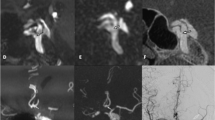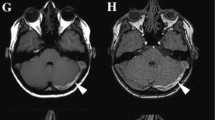Abstract
This study assessed the ability to diagnose carotid-cavernous fistulas (CCFs) non-invasively using magnetic resonance angiogrphy (MRA). Both three-dimensional time-of-flight (3-D TOF) MRA and three-dimensional phase-contrast (3-D PC) MRA were compared with conventional cerebral angiography in nine patients with CCFs. CCFs were grouped according to Barrow's classification. In all cases, 3-D TOF MRA revealed an inferior petrosal sinus as a draining vein. 3-D PC MRA demonstrated a dilated and tortuous superior ophthalmic vein (SOV) and reflux of the SOV in seven patients. In conclusion, CCFs can be diagnosed with MRA alone by demonstrating the drainging veins.
Similar content being viewed by others
References
Awad IA, JR Little: Dural arteriovenous malformations: In: Barrow DL (ed). Intracranial vascular malformations. Park Ridge: American Association of Neurological Surgeons (1990) 219–26
Barrow DL, RH Spector, IF Braun, JA Landman, SC Tindall, GT Tindall: Classification and treatment of spontaneous carotid-cavernous sinus fistulas. J Neurosurg 62 (1985) 248–56
Chen JC, JS Tsuruda, VV Halsbach: Suspect arteriovenous fistula: Results with screening MR angiography in seven patients. Radiology 183 (1992) 265–71
Daniels DL, LF Czervionke, JF Bonneville, F Cattin, LP Mark, P Pech, LE Hendrix, DF Smith, VM Haughton, AL Williams: MR imaging of the cavernous sinus: value of spin echo and gradient recalled echo images. AJNR 9 (1988) 947–52
Daniel DL, P Pech, L Mark,KW Pojunas, A Williams,VM Haughton: Magnetic resonance imaging of the cavernous sinus. AJNR 6 (1985) 187–92
Dumoulin CL, HR Hart: Magnetic resonance angiography. Radiology 161 (1986) 712–20
Dumoulin CL, SP Souza, MF Walker, W Wagle: Three dimensional phase contrast angiography. Magn Reson Med 9 (1989) 139–49
Huston J, DA Rufenacht, RL Ehman, DO Wiebers: Intracranial aneurysms and vascular malformations: comparison of time-of-flight and phase-contrast MR angiography. Radiology 181 (1991) 721–30
Ikawa F, M Sumida, T Uozumi, K Kiya, K Kurisu, K Arita, H Satoh: Demonstration of the venous systems with Gadolinium enhanced three-dimensional phase-contrast MR venography. Neurosurg Review 18 (1995) 101–107
Newton TH, WF Hoyt: Dural arteriovenous shunts in the region of the cavernous sinus. Neuroradiology 1 (1970) 71–81
Pernicone JR, JE Siebert, TA Laird, TL Rosenbaum, EJ Potchen: Determination of blood flow direction using velocity-phase image display with 3-D phase-contrast MR angiography. AJNR 13 (1992) 1435–438
Vinuela F, AJ Fox, GM Debrun,SJ Peerless, CG Drake: Spontaneous carotid-cavernous fistulas: clinical, radiological, and therapeutic considerations. Experience with 20 cases. J Neurosurg 60 (1984) 976–84.
Wehrli FW: Time-of-flights effects in MR imaging of flow. Magn Reson Med 14 (1990) 187–93
Wehrli FW, A Shimakawa, GT Gullberg, JR Macfall: Time-of-flight MR selective saturation recovery with gradient refocusing. Radiology 160 (1986) 781–85
Author information
Authors and Affiliations
Rights and permissions
About this article
Cite this article
Ikawa, F., Uozumi, T., Kiya, K. et al. Diagnosis of carotid-cavernous fistulas with magnetic resonance angiography—demonstrating the draining veins utilizing 3-D time-of-flight and 3-D phase-contrast techniques. Neurosurg. Rev. 19, 7–12 (1996). https://doi.org/10.1007/BF00346602
Received:
Accepted:
Issue Date:
DOI: https://doi.org/10.1007/BF00346602




